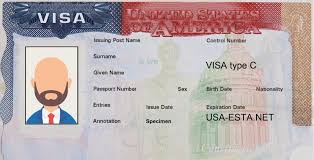USA Transit Visa: A Comprehensive Guide

Traveling to the United States can often require more than just a final destination. For many international travelers, a stopover in the U.S. is part of their journey to another country. This situation typically necessitates a USA transit visa, a specific type of visa intended for those passing through the country on their way elsewhere. The importance of understanding the requirements, application process, and regulations surrounding the USA TRANSIT VISA cannot be overstated, as it ensures a smooth and hassle-free travel experience.
What is a USA Transit Visa?
A USA transit visa, also known as the C-1 visa, is a non-immigrant visa for individuals traveling in immediate and continuous transit through the United States en route to another country. This visa category is strictly for those who do not intend to stay in the U.S. and will only remain in the country for a short period before continuing their journey. It is important to note that holding a C-1 visa does not allow travelers to visit family, friends, or engage in business activities within the United States.
Eligibility Criteria for a Transit Visa
To qualify for a USA transit visa, applicants must meet specific eligibility criteria set by the U.S. Department of State. These include:
- Intent to Transit: The primary purpose of the visit must be to pass through the United States to reach another country. Applicants must provide evidence of their travel plans, including tickets and a valid visa for their final destination if required.
- No Intent to Stay: Applicants must demonstrate that they have no intention of remaining in the United States. This typically involves showing ties to their home country, such as a job, family, or property.
- Financial Means: Travelers must prove they have sufficient funds to cover their stay and onward travel. This ensures that they will not become a financial burden on the U.S. government.
- Security and Health Clearance: Applicants must not pose a security risk to the United States and should pass a medical examination if required.
Application Process for a Transit Visa
The application process for a USA transit visa involves several steps, which need to be meticulously followed to increase the chances of approval. Here is a detailed breakdown:
Step 1: Complete the DS-160 Form
The first step in applying for a USA transit visa is to fill out the DS-160 form, an online non-immigrant visa application. This form collects personal information, travel details, and background information about the applicant. It is crucial to ensure all information is accurate and truthful, as discrepancies can lead to delays or denial of the visa.
Step 2: Pay the Visa Fee
Once the DS-160 form is completed, applicants must pay the non-refundable visa application fee. The fee for a C-1 transit visa is currently $160, but it is always wise to check the latest fee on the official U.S. Department of State website. Payment can typically be made online or at designated banks, depending on the applicant’s country of residence.
Step 3: Schedule the Visa Interview
After paying the visa fee, applicants need to schedule an appointment for a visa interview at the nearest U.S. embassy or consulate. The wait time for an interview can vary based on location, season, and the specific embassy or consulate, so it is advisable to schedule early.
Step 4: Prepare for the Interview
Preparing for the visa interview is a critical step. Applicants should gather all necessary documents, including:
- A valid passport.
- The DS-160 confirmation page.
- The visa application fee receipt.
- A passport-sized photograph that meets U.S. visa requirements.
- Evidence of onward travel (e.g., flight itinerary).
- Proof of financial means.
- Any other documents that support the purpose of transit and ties to the home country.
Step 5: Attend the Visa Interview
During the visa interview, a consular officer will assess the applicant’s eligibility for a transit visa. The officer may ask questions about the travel itinerary, purpose of transit, financial situation, and ties to the home country. It is essential to answer all questions honestly and provide any requested documents. USA VISA ELIGIBLITY QUESTIONS
Common Reasons for Visa Denial
While many applicants successfully obtain a USA transit visa, some face denial. Common reasons for visa denial include:
- Insufficient Evidence of Transit Purpose: Failing to convincingly demonstrate the primary purpose of transiting through the U.S.
- Weak Ties to Home Country: Inability to prove strong ties to the home country, suggesting a risk of overstaying.
- Inadequate Financial Proof: Not showing enough financial resources to cover the stay and onward travel.
- Incomplete Documentation: Missing or incorrect documentation can lead to immediate rejection.
- Security Concerns: Any indication that the applicant poses a security risk to the United States.
Tips for a Successful Transit Visa Application
To enhance the chances of securing a USA transit visa, applicants can follow these tips:
Be Thorough and Accurate
Ensure that all information provided in the DS-160 form and during the interview is complete, accurate, and truthful. Double-check all entries to avoid mistakes.
Provide Strong Evidence
Present clear and convincing evidence of your travel plans, financial stability, and ties to your home country. Detailed documentation can significantly strengthen your application.
Prepare for the Interview
Practice answering potential questions that may be asked during the visa interview. Confidence and clarity in your responses can positively influence the consular officer’s decision.
Follow Up if Necessary
If your visa is denied, understand the reasons for the denial and address any shortcomings before reapplying. Sometimes additional documentation or clarification can resolve the issues that led to the initial denial.
Exemptions and Special Cases
Certain travelers might be exempt from needing a USA transit visa or might fall under special categories:
Visa Waiver Program
Citizens of countries participating in the Visa Waiver Program (VWP) can transit through the United States without a visa, provided they meet all the program’s requirements. However, they must have a valid Electronic System for Travel Authorization (ESTA) approval before boarding.
Crew Members
Crew members of international airlines or sea vessels typically require a different type of visa (D visa) rather than a transit visa. They should apply for the appropriate visa category to avoid complications.
Diplomats and Government Officials
Diplomats and government officials on official duty may be eligible for a diplomatic visa (A visa) or other specific categories that waive the need for a transit visa.
Renewal and Extension of Transit Visa
A USA transit visa is usually valid for a short period, often just a few days. However, in some cases, travelers might need to extend their stay due to unforeseen circumstances such as flight delays or cancellations. Here’s how to handle such situations:
Renewal
Generally, transit visas are not renewable. If your travel plans change, requiring you to transit through the U.S. again at a later date, you will need to apply for a new visa.
Extension
Extensions of a transit visa are rare and typically only granted in exceptional circumstances. If you find yourself in a situation where you need to extend your stay, contact the U.S. Citizenship and Immigration Services (USCIS) immediately for guidance.
Impact of COVID-19 on Transit Visas
The COVID-19 pandemic has significantly impacted international travel, including transit visas. Travelers need to be aware of the latest restrictions, health and safety protocols, and any changes in visa processing procedures:
Travel Restrictions
Check for any travel restrictions or entry bans related to COVID-19 before planning your transit through the United States. These can change frequently based on the global and local situation.
Health Protocols
Be prepared to comply with health protocols such as testing, quarantine requirements, and vaccination mandates. Ensure you have all necessary documentation related to your health status.
Visa Processing Delays
COVID-19 has caused delays in visa processing times at many U.S. embassies and consulates. Schedule your visa appointment well in advance and be prepared for potential delays.
Conclusion
Navigating the requirements and processes for obtaining a USA transit visa can seem daunting, but with careful preparation and understanding of the necessary steps, it can be straightforward. By ensuring eligibility, providing thorough documentation, and being prepared for the visa interview, travelers can secure their transit visa and ensure their journey through the United States is smooth and trouble-free.
In a world where international travel is becoming increasingly complex, understanding the nuances of transit visas is more important than ever. For those transiting through the U.S., a C-1 visa is a crucial step in ensuring their travel plans proceed without interruption. By following the guidelines and tips outlined in this comprehensive guide, travelers can navigate the transit visa process with confidence and ease.
